Executive Summary
- Pulsed TIG lowers heat input; increases precision and quality.
-
High-speed pulsing constricts and focuses the arc, which increases arc stability, penetration and travel speed, while producing a smaller heat affected zone.
-
An inverter like the Dynasty 200 draws 16 amps at rated output – 1/5th the primary power draw of a conventional TIG welder.
-
Lower heat input minimizes distortion and improves weld quality.
-
Inverters like the Dynasty 200 allow for pulsing as high as 5,000 pulses per second.
-
Increased productivity allowed Big Gun to bring more exhaust fabrication in-house for controlled quality and increased production – from 50 to 150 units per week.
TIG Welding at Warp Speed—Without the Warping
After-market exhaust system manufacturer more than triples production with Dynasty 200 TIG welder
Who said power must be a struggle? For Big Gun Exhaust, manufacturer of after-market exhaust systems, achieving power is easy, but that’s not what sets the company apart from its competitors. Boosting performance is much more than adding a pipe; it’s adding a pipe that produces the right kind of power—over and over again.
Located in Rancho Cucamonga, Calif., Big Gun Exhaust has achieved its goal: from ATVs to street bikes, the company covers everything in an exhaust system that a performance enthusiast needs, or wants. But with worldwide distribution, they are more than a one-stop shop; they are a leading manufacturer of after-market exhaust pipes. In fact, they have grown to the third largest supplier in the ATV market.
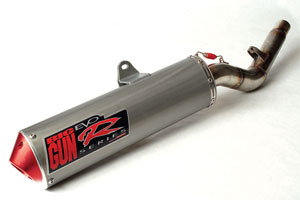 |
|
The EVO R Series is a complete high-performance exhaust system specifically designed to meet the versatile needs of today’s aggressive motocross racing enthusiast. It features a lightweight .304 stainless steel header and offers extreme power and smooth torque delivery.
|
Growth hasn’t come without problems, however. Mike Young, owner of Big Gun and a championship motorcycle racer, began the company with the belief that he could outsource everything but the design of his product.
“Unfortunately, you can never get the product on time, pricing is never right and the quality isn’t what you want,” says Young. “So last year we decided to build it in-house, and now we build a piece the way we really want to build it, so the quality is superior. We build every piece by hand.”
From only 75 pipes per week to its current production of 150, Big Gun has learned a lot about the manufacturing process. Because every pipe has 6 to 16 fixtures, welding is the largest part of the process and the Dynasty™ 200 TIG welder from Miller Electric Mfg. Co. made a world of difference for welding .035 - .304 stainless steel pipe. “The Dynasty got us up to 50 pipes right away,” says Young. “Then we went to 75 because we figured out some ways to make the process faster. Within the next four weeks, we should be kicking out 150 a week.”
Big Gun was founded, however, with simpler goals in mind, and as a result of unforeseen circumstances.
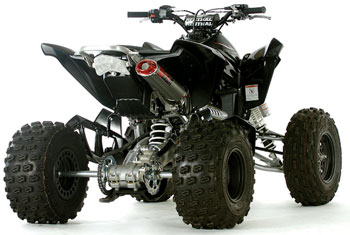 |
|
Big Gun offers complete and slip-on exhaust systems for ATV, motocross and snowmobile racing enthusiasts.
|
Almost 11 years ago, when a motorcycle accident confined Young to a wheelchair, the multi-time national four-stroke champion began thinking about all he had learned from riding bikes. “After my crash, when I was in rehab, I thought, ‘I’ve got to do something,’ and I wanted to do something in this industry,” says Young.
Previously, Young was a test rider for major manufacturers, such as Honda, Suzuki and Yamaha, and helped with research and development. He was known as a “four-stroke guy” because he started riding four stroke bikes before anyone else. He started competing in 1991 and won his first championship in 1992. In all, Young has won three national four-stroke championships and one four-stroke world title.
In 1995, he had the opportunity to work hands-on with a manufacturer in Europe. Here, Young developed a solid understanding of and fervent passion for the intricacies of the performance enhancing pipes and how power can be controlled differently.
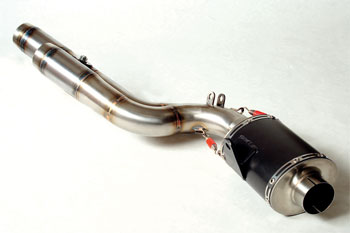 |
|
Lighter than a stock exhaust system, Big Gun designed the EVO Mini Series seen here to offer an 8 to 10 percent power increase with a deep, bold sound that meets the 94-96 dB noise regulations established by the U.S. Forest Service.
|
“I’m the only four-stroke exhaust company that is actually run by an actual four-stroke champion,” says Young. “What this means is that the customer receives a quality product that’s built to win. I know what it takes.”
Now, with 13 employees, as well as three at a powder coating and ceramic coating facility next door, Big Gun sells to dealers around the world. While Big Gun is ramping up in-house production, Young still sees the importance of slow and steady growth to achieve the highest quality product.
“We need to be kicking out 200, 250 units a week, and that’s not enough to meet demand, but we’ve got to take gradual steps,” says Young. “We still have to outsource to one other shop, but we finish it here. We double check everything and then package and ship them.”
Bringing it Home
Manufacturing is a lot more difficult than it appears, according to Young. It has sped up production, but made pricing more complicated.
“Look at how many hands had to touch it, all the R&D behind it,” says Young. “It’s a very intricate process and has taken us in a different direction than we ever thought.”
 |
|
Big Gun’s EVO Mini Series is seen on this Suzuki bike in a double pipe configuration.
|
Considering that many pipes require up to 16 fixtures, consistency and quality control are critical to the company’s in-house operations. Before an exhaust system is ready for manufacturing, fixtures must be custom fitted. “One of our most rigorous processes is the fixturing process because the fixture replicates the exhaust system,” says Young. “It’s a very tedious process but a fruitful one because we take the time. Our product is going to fit better than when we outsourced because now we have fixtures that match the whole pipe.”
Following the prototyping and fixturing process, once the fixtures fit together perfectly, the system is welded—very carefully.
“You’ve got to be so cautious and careful that you don’t distort it, because when the pipe gets hot, the materials move,” says Young. “The part has to fit into the fixture without a problem or it goes into the trash and we start over.” Between these two steps, fit-up and welding, there is simply no room for error. Each fabricated pipe must be identical to the next and perform exactly the same way.
Tripling Production
In terms of welding alone, the Dynasty helps Big Gun achieve uniformity because, among other things, operators have more heat input control with the Dynasty. “The crucial part of welding is not getting it too hot, to where it changes its shape and doesn’t fit in the fixture,” says Frank Sison, head of manufacturing. “With the Dynasty, I get a finer bead so the part actually stays cooler and doesn’t warp.”
Greater control is just one benefit of this advanced inverter-based power source. The Dynasty has a state-of-the-art operator interface that offers a built-in pulser and more control of output parameters than a traditional TIG machine. Prior to using the Dynasty 200 DX, Sison hadn’t worked with a pulser, but he now appreciates pulsing for reducing heat input and adding arc stability.
“I used to just do it myself, with my hand going up and down, up and down,” says Sison. “The pulser is an ideal feature that, now, I don’t think I can work without.” [See sidebar story for more information on pulsing.]
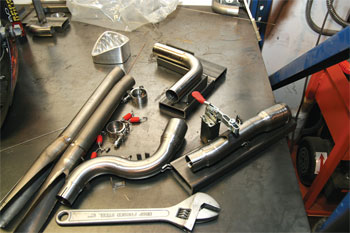 |
|
Before an exhaust system is ready for manufacturing, fixtures must be custom fitted from a finalized prototype. Considering that many pipes require up to 16 fixtures, consistency and quality control are critical to the company’s in-house operations.
|
With roughly a few hundred fixtures, and welding from .035 to .085 stainless, the ability to fine tune output parameters saves Big Gun significant time. “You get exactly the right size bead as you weld it,” says Sison. “And you don’t need to go over it and make it look pretty, because it’s pretty the first time.”
Young agrees: “Our welds look like a robot welded them, but better because they are just so flawless, so perfect. The fabrication is so clean, and everything has been deburred so well that it’s smooth, which is important because burs can kill the power.”
Further, starts are smoother with the Dynasty.
“I can put the Dynasty on a lower amperage and actually work with it,” says Sison. “With our older machine, we could only go so low and it wouldn’t want to start. And when it did, it would blow a hole. You can actually finesse your start, and that’s what I really like about the Dynasty.”
The Dynasty’s advanced inverter technology with Auto-Line™ Power Management Technology allows Big Gun to hookup to 120 to 460 V, single- or three-phase power with no manual linking, as well as reduces power draw—and headaches. “Our other machine sucked so much power out of this place,” says Young. “It was always popping breakers, it was crazy. You don’t even notice the Dynastys. We can run three at one time without any problem.”
At a rated output of 150 amps, the Dynasty draws only 15.8 amps of primary power. Compared to a conventional 250 amp TIG welder, the Dynasty uses primary power 4 to 5 times more efficiently. With an amperage draw this low, Big Gun is able to plug in five Dynastys for every one conventional welder.
From the welding station, the system moves to the most telling step in the manufacturing process: performance analysis and testing.
Mapping Power
When it comes to testing products, Big Gun’s standards go beyond horsepower. “What I want out of a pipe isn’t necessarily the most horsepower,” says Young. “I want to give the top pro, or the guy that’s just learning, the best power band they will ever get.”
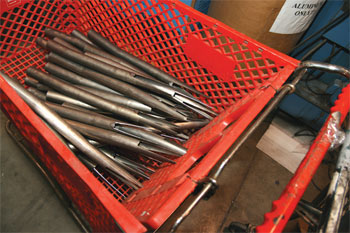 |
|
Numerous tubes of the same size are cut to begin the manufacturing process.
|
Most manufacturers choose to use a Dynamometer, where a vehicle is run through its pace, power is calculated and it goes into production. But the machine is only a tool, however; it can’t determine what the vehicle will do when it’s driven on a real track by a live person.
While the company does “dyno” test its system for adjustment purposes, they begin testing by mapping the exhaust system. Computer mapping software shows the dimensions that a pipe needs to be to suit the desired style. Then Big Gun’s engineer uses his 30-plus years experience to put the numbers together.
“I correspond with my engineer and we build the pipe to match the bike,” says Young. “At the end of the day, what matters is performance on the track. For example, some vehicles have a lot of torque power, and we know exactly how to change it to broaden the power. If all the power is in one area, it’s explosive. It blows up and then the power is gone.”
But even before a vehicle, in this case a bike, hits the track, Big Gun takes it to the street for a little “alley testing.”
“We’ll do it right here in the alley, because on the street, if you roll the throttle, you keep the wheel spin to a minimum and you can really feel how exhaust design affects the power band,” says Young. They run a bike through its gears, check times and continue to test different systems.
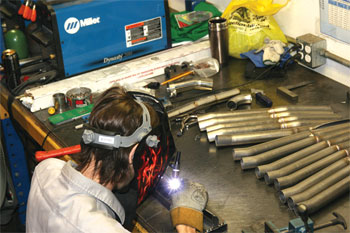 |
|
Each fabricated pipe must be identical to the next in the fixture to perform exactly the same way. The high-speed pulsing feature of the Dynasty 200 DX constricts and focuses the arc, allowing operators greater control over both the arc stability and heat input so parts stay cool and avoid warping.
|
Then Big Gun takes it to the track, where a customer rides 10 to 15 laps with the stock pipe on the bike. Next, without telling the customer which pipe is on the bike, the customer does the same 10 to 15 laps with the Big Gun pipe. The customer goes out one more time with the stock pipe and notes any differences. Adjustments are made accordingly.
“If it doesn’t have enough of this or too much of that, we move the power around the next time by modifying the pipe,” says Young. “If it has too much low-end torque, we’re going to move the power out a little bit more to the middle and the top.”
Big Gun’s practice is to make sure its system fits the needs of the user. If it doesn’t, Big Gun will modify it and only then put it into production.
“The customer wants his new pipe to be better than what he has,” says Young. “If we inflate our numbers and say, ‘you gain 16 horsepower,’ and he gets on it and says it’s slow, we look stupid. Our competitors tend to throw out huge numbers and it makes no sense, because everyone is different and possesses a different riding style.”
Once Big Gun reaches the desired power return, the company fabricates a custom fixture for volume fabrication of the system. This ensures that each pipe fabricated is identical to the next and performs equally well.
What’s In a Namesake?
Fittingly, the Big Gun name came from a bike that Young rode in ’93.
“The reason they called it Big Gun was that this bike was amazing,” says Young. “Honda built it for me. It was so fast that no one else could handle it.” Young felt his after-market exhaust systems deserved the same legacy, but his attitude is far from high and mighty.
“When all’s said and done, it’s about building a quality product, 100 percent made in America, with all the features built into it,” says Young. “It’s like a Miller welder. You get the best product for your money the first time. You don’t have to add it later.” In other words, Young would rather bring out the Big Guns the first time around.
Struggling with Stainless? Pulsed TIG Provides a Solution
The challenge of welding thin gauge stainless steel involves achieving adequate penetration without overheating it. Unlike other metals, stainless steel does not adequately dissipate heat when welded. It holds heat in the area where the welding arc is concentrated. Excess heat causes major problems: warping, embrittlement and rust.
 |
|
The finished EVO X Series exhaust system has numerous pipe configurations available.
|
Warping usually leads to a part being scrapped, which is a costly waste. Temperature ranges of 950- to 1850-degrees F or higher can cause stainless to become brittle, so the metal’s mechanical properties might not meet required specifications.
Excess heat also boils off stainless’ alloying elements and concentrates the carbon, which remains trapped in heat-affected zone when the metal cools. Given time, the area overloaded with carbon will rust. This phenomenon is commonly called carbide precipitation, and it results from “burning out the chrome.” Burning out the chrome could lead to rusting (stainless steel’s best-known property), which may increase warranty costs.
Pulsed TIG Beats the Heat
Whenever excess heat, loss of mechanical properties and warping are an issue, consider a pulsed welding process for the solution. With pulsed TIG, the arc pulses between a high peak and low background current (see chart). The peak current provides good penetration, but the background current allows the weld puddle to cool slightly, preventing warping, embrittlement and carbide precipitation.
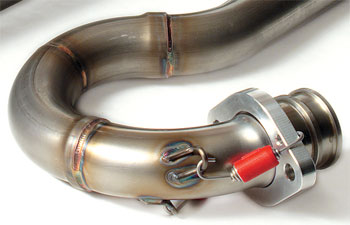 |
|
This close-up shows the weld bead and its relatively small heat affected zone on .304 stainless steel pipe. A small heat affected zone helps to avoid warping and ensures precision fit and performance.
|
Higher pulsing (generally above 100 pulses per second) increase puddle agitation, which in turn produces a better grain molecular structure within the weld. High speed pulsing also constricts and focuses the arc. This increases arc stability, penetration and travel speeds, and it produces a smaller heat-affected zone.
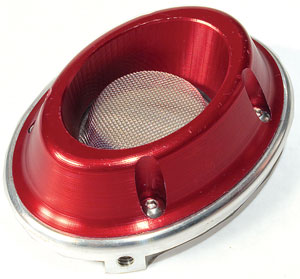 |
|
The long, smooth shape of CNC billet aluminum end cap looks good and restricts noise levels for racing events. Various colors are available for all Big Gun exhaust systems.
|
High speed pulsed TIG requires using a TIG inverter, such as Miller’s Dynasty® series. Conventional TIG technology limits pulsing to a relatively narrow range of .25 to 10.0 pulses per second (PPS), where inverter technology enables pulsed at up to 5,000 PPS.
Suggesting Starting Variables
Pulsed TIG welding requires setting four variables: peak amperage, background amperage, peak time and pulse rate. Determining good values for setting peak amperage works much the same as setting maximum amperage values for regular DC TIG: use 1 amp for every .001 in. of thickness.
The peak time is simply the percentage of time during one pulsing cycle the power source spends at the peak amperage (main amperage). With peak time of 80 percent and a rate of 1 pulse per second (PPS), the inverter will spend 8/10ths of a second at peak amperage and 2/10ths of a second at the background amperage. Increasing the peak time percentage adds more heat to the part, while decreasing peak time percentage reduces heat. As general rule of thumb, begin experimenting at 50 to 60 percent peak time.
The background amperage will be a percentage of the main amperage set on the machine. Thus, a machine set for an output of 150 amps and background amperage of 30 percent produces a background amperage output of 45 amps. Lowering the background amp percentage reduces the average heat input, while increasing the background amp percentage raises the overall amperage.
Especially notice how background current adjustments affect weld puddle fluidity. As a rule, use enough background current to shrink the puddle to about half its normal size while still keeping the puddle fluid. When welding stainless and carbon steels, start by setting the background amperage at 20 to 30 percent of peak amperage.
PPS is simply how many times the machine will complete one pulsing cycle in a time span of one second. Increasing the number of pulses per second produces a smoother the ripple effect in the weld bead, narrows the weld bead and adds more “cooling affect.” Reducing the number of pulses per second widens the weld bead. Slower pulsing also helps agitate the puddle and release any porosity or gas trapped in the weld (this is very helpful when welding aluminum with AC pulsed TIG).
Some beginning TIG welders use a slow pulsing rate (perhaps .5 to 1 PPS) to help them develop a rhythm for adding filler metal. For welding carbon or stainless steel, use a rate of 100 to 500 PPS. Start at 100 and work upward. Note that rates higher than 500 PPS are generally automated.
Depending on the part being welded, the cost of just a few scrapped parts or warranty claims could more than outweigh the cost of upgrading to a new inverter with advanced pulsed TIG capabilities. Also, consider that pulsed TIG makes it easier for welding operators to achieve betters results, so they’ll enjoy welding more.